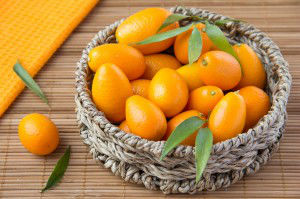
The kumquat (also spelled cumquat) is native to the Southeastern mountains of China, as well as to regions of Japan and the Philippines. In the Cantonese language, “kum” means golden, and “quat” means good fortune. This little citrus fruit is mentioned in ancient Chinese literature dating back to 118 BC.
Kumquats grow on subtropical evergreen shrubs, and are often used ceremonially and ornamentally across Asia. They are traditionally displayed during Chinese New Year.
Part of the Rutaceae (citrus) family, their genus name is Fortunella, after Robert Fortune, a botanist who brought these fruits to Europe in the mid-1800s. In the West, they have been cultivated in Hawaii since around this same time period, where they were likely introduced by Chinese immigrants.
One small kumquat tree can bear hundreds of kumquats each winter. A kumquat resembles a very small orange, with inner segments pressed close together, and one or two seeds inside, which are not usually eaten. Unlike most other citrus fruits, kumquats can be eaten whole along with the rind. Their flavor is sweet or tart, or a combination of the two, depending on variety.
What’s inside?
Each of these miniature delicacies contains:
- Calcium
- Copper
- Fiber
- Folate
- Iron
- Magnesium
- Manganese
- Pantothenic acid
- Potassium
- Protein
- Vitamin A
- Vitamins B1, B2, B3 and B6
- Vitamin C
- Vitamin E
Health benefits
Kumquats are loaded with flavonoid antioxidant compounds, including beta-carotene, lutein, quercetin, rutin and zeaxanthin. These compounds fight oxidative stress damage to cells, helping to prevent many chronic diseases and minimizing the effects of aging.
Like other citrus fruits, kumquats contain a high amount of vitamin C, a potent antioxidant that supports the immune system in preventing and ridding the body of infections. Vitamin C is also important to healthy skin, helps the body to absorb iron, boosts cognitive function and may help to alleviate seasonal depression.
One of the main benefits of kumquats is that they can be eaten whole, with the entire peel intact. The peel is the source of the most concentrated antioxidants, and also contains fiber and health-promoting essential oils.
One of these essential oils is limonene, which has been linked to potent anti-inflammatory action. Limonene is also associated with improved digestion, better metabolic function, anxiety relief, liver detoxification and anti-carcinogenic properties.
Kumquats are a great part of a heart-healthy diet, as they may help to lower LDL ‘bad’ cholesterol and improve circulation. Their flavonoid content is also associated with reduction in blood sugar levels, and their fiber content contributes to this as well. In Vietnam, kumquat syrup is used to soothe sore throats.
 Kumquats are also traditionally used throughout Asia to treat respiratory conditions such as asthma, bronchitis and coughs, as their essential oils are antibacterial in nature and help to break up mucus.
Kumquats are also traditionally used throughout Asia to treat respiratory conditions such as asthma, bronchitis and coughs, as their essential oils are antibacterial in nature and help to break up mucus.
Additionally, kumquats are great for freshening the breath, as the essential oils in the peel fight odor-causing bacteria in the mouth.
-The Alternative Daily
Sources:
http://www.nutrition-and-you.com/kumquat-fruit.html
http://www.pennlive.com/bodyandmind/index.ssf/2011/12/kumquat_a_healthy_pick.html
http://www.hawaiifruit.net/kumquat.htm
http://www.botanical-online.com/english/kumquat_properties.htm
http://www.essentialoilseeker.com/?p=1432
http://www.wellnessresources.com/health/articles/d-limonene_help_for_digestion_metabolism_detoxification_anxiety_breast_canc

